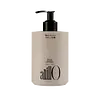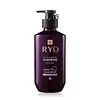What's inside
What's inside
 Key Ingredients
Key Ingredients

 Benefits
Benefits

 Concerns
Concerns

 Ingredients Side-by-side
Ingredients Side-by-side

Water
Skin ConditioningDisodium Laureth Sulfosuccinate
CleansingGlycine Soja Seed Extract
Skin ConditioningLactobacillus Ferment Lysate
Skin ConditioningSaccharomyces Ferment Filtrate
HumectantCocamidopropyl Hydroxysultaine
CleansingSodium Cocoyl Isethionate
CleansingCoco-Glucoside
CleansingAcrylates Copolymer
Parfum
MaskingSodium Lauroyl Methylaminopropionate
CleansingDecyl Glucoside
CleansingArginine
MaskingSodium Chloride
MaskingMethylpropanediol
SolventMannitol
HumectantStyrene
Perfuming1,2-Hexanediol
Skin ConditioningCaprylyl Glycol
EmollientPolyquaternium-22
PPG-3 Caprylyl Ether
SolventCetyl Alcohol
EmollientTrihydroxystearin
Skin ConditioningPanthenol
Skin ConditioningPolyquaternium-10
Salicylic Acid
MaskingMicrocrystalline Cellulose
AbsorbentSucrose
HumectantEthylhexylglycerin
Skin ConditioningNiacinamide
SmoothingZea Mays Starch
AbsorbentMalt Extract
Skin ProtectingDisodium EDTA
Hydroxypropyl Methylcellulose
Emulsion StabilisingCitric Acid
BufferingBenzoic Acid
MaskingButylene Glycol
HumectantMyristyl Alcohol
EmollientCocamide Mipa
EmulsifyingHyaluronic Acid
HumectantTriticum Vulgare Germ Extract
Skin ConditioningStearyl Alcohol
EmollientLactobacillus
Skin ConditioningAvena Sativa Kernel Extract
AbrasiveOryza Sativa Extract
AbsorbentSalmon Egg Extract
Berberis Vulgaris Root Extract
AntimicrobialFragaria Chiloensis Fruit Extract
Skin ConditioningLycium Barbarum Fruit Extract
AstringentMorus Alba Fruit Extract
AntioxidantHydrolyzed Wheat Protein
Skin ConditioningPropanediol
SolventLinalool
PerfumingWater, Disodium Laureth Sulfosuccinate, Glycine Soja Seed Extract, Lactobacillus Ferment Lysate, Saccharomyces Ferment Filtrate, Cocamidopropyl Hydroxysultaine, Sodium Cocoyl Isethionate, Coco-Glucoside, Acrylates Copolymer, Parfum, Sodium Lauroyl Methylaminopropionate, Decyl Glucoside, Arginine, Sodium Chloride, Methylpropanediol, Mannitol, Styrene, 1,2-Hexanediol, Caprylyl Glycol, Polyquaternium-22, PPG-3 Caprylyl Ether, Cetyl Alcohol, Trihydroxystearin, Panthenol, Polyquaternium-10, Salicylic Acid, Microcrystalline Cellulose, Sucrose, Ethylhexylglycerin, Niacinamide, Zea Mays Starch, Malt Extract, Disodium EDTA, Hydroxypropyl Methylcellulose, Citric Acid, Benzoic Acid, Butylene Glycol, Myristyl Alcohol, Cocamide Mipa, Hyaluronic Acid, Triticum Vulgare Germ Extract, Stearyl Alcohol, Lactobacillus, Avena Sativa Kernel Extract, Oryza Sativa Extract, Salmon Egg Extract, Berberis Vulgaris Root Extract, Fragaria Chiloensis Fruit Extract, Lycium Barbarum Fruit Extract, Morus Alba Fruit Extract, Hydrolyzed Wheat Protein, Propanediol, Linalool
Water
Skin ConditioningSodium Laureth Sulfate
CleansingAmmonium Lauryl Sulfate
CleansingGlycerin
HumectantCocamide Mea
EmulsifyingParfum
MaskingDisodium Laureth Sulfosuccinate
CleansingLauryl Hydroxysultaine
CleansingCaffeine
Skin ConditioningPPG-3 Caprylyl Ether
SolventAlcohol Denat.
AntimicrobialPhenoxyethanol
PreservativeSodium Benzoate
MaskingCetyl Alcohol
EmollientMenthol
MaskingGuar Hydroxypropyltrimonium Chloride
Skin ConditioningCitric Acid
BufferingSodium Salicylate
PreservativeCaprylic/Capric Triglyceride
MaskingTrihydroxystearin
Skin ConditioningSodium Citrate
BufferingDicaprylyl Ether
EmollientTetrasodium EDTA
Butylene Glycol
HumectantMalt Extract
Skin ProtectingDisodium EDTA
Linalool
PerfumingPEG-45m
HumectantGlyceryl Stearate
EmollientMentha Arvensis Leaf Extract
MaskingBenzyl Salicylate
PerfumingHexyl Cinnamal
PerfumingBenzyl Benzoate
AntimicrobialGeraniol
PerfumingAlpha-Isomethyl Ionone
PerfumingHydrolyzed Corn Starch
HumectantCaprylyl Glycol
EmollientPinus Densiflora Leaf Extract
Antimicrobial1,2-Hexanediol
Skin ConditioningDehydroacetic Acid
PreservativePanax Ginseng Extract
AntioxidantPanax Ginseng Root Extract
EmollientSilica
AbrasiveZingiber Officinale Root Extract
MaskingEthylhexylglycerin
Skin ConditioningTocopherol
AntioxidantOryza Sativa Extract
AbsorbentImperata Cylindrica Root Extract
Skin ConditioningScutellaria Baicalensis Root Extract
AstringentSesamum Indicum Seed Extract
Skin ConditioningLonicera Japonica Flower Extract
Skin ConditioningCalendula Officinalis Flower Extract
MaskingTribulus Terrestris Fruit Extract
Skin ConditioningCamellia Japonica Seed Oil
EmollientCamellia Sinensis Seed Oil
HumectantPEG-150 Pentaerythrityl Tetrastearate
EmulsifyingPPG-2 Hydroxyethyl Cocamide
EmulsifyingPolygonum Multiflorum Root Extract
Skin ConditioningWater, Sodium Laureth Sulfate, Ammonium Lauryl Sulfate, Glycerin, Cocamide Mea, Parfum, Disodium Laureth Sulfosuccinate, Lauryl Hydroxysultaine, Caffeine, PPG-3 Caprylyl Ether, Alcohol Denat., Phenoxyethanol, Sodium Benzoate, Cetyl Alcohol, Menthol, Guar Hydroxypropyltrimonium Chloride, Citric Acid, Sodium Salicylate, Caprylic/Capric Triglyceride, Trihydroxystearin, Sodium Citrate, Dicaprylyl Ether, Tetrasodium EDTA, Butylene Glycol, Malt Extract, Disodium EDTA, Linalool, PEG-45m, Glyceryl Stearate, Mentha Arvensis Leaf Extract, Benzyl Salicylate, Hexyl Cinnamal, Benzyl Benzoate, Geraniol, Alpha-Isomethyl Ionone, Hydrolyzed Corn Starch, Caprylyl Glycol, Pinus Densiflora Leaf Extract, 1,2-Hexanediol, Dehydroacetic Acid, Panax Ginseng Extract, Panax Ginseng Root Extract, Silica, Zingiber Officinale Root Extract, Ethylhexylglycerin, Tocopherol, Oryza Sativa Extract, Imperata Cylindrica Root Extract, Scutellaria Baicalensis Root Extract, Sesamum Indicum Seed Extract, Lonicera Japonica Flower Extract, Calendula Officinalis Flower Extract, Tribulus Terrestris Fruit Extract, Camellia Japonica Seed Oil, Camellia Sinensis Seed Oil, PEG-150 Pentaerythrityl Tetrastearate, PPG-2 Hydroxyethyl Cocamide, Polygonum Multiflorum Root Extract
 Reviews
Reviews

Ingredients Explained
These ingredients are found in both products.
Ingredients higher up in an ingredient list are typically present in a larger amount.
1,2-Hexanediol is a synthetic liquid and another multi-functional powerhouse.
It is a:
- Humectant, drawing moisture into the skin
- Emollient, helping to soften skin
- Solvent, dispersing and stabilizing formulas
- Preservative booster, enhancing the antimicrobial activity of other preservatives
Butylene Glycol (or BG) is used within cosmetic products for a few different reasons:
Overall, Butylene Glycol is a safe and well-rounded ingredient that works well with other ingredients.
Though this ingredient works well with most skin types, some people with sensitive skin may experience a reaction such as allergic rashes, closed comedones, or itchiness.
Learn more about Butylene GlycolCaprylyl Glycol is a humectant and emollient, meaning it attracts and preserves moisture.
It is a common ingredient in many products, especially those designed to hydrate skin. The primary benefits are retaining moisture, skin softening, and promoting a healthy skin barrier.
Though Caprylyl Glycol is an alcohol derived from fatty acids, it is not the kind that can dry out skin.
This ingredient is also used as a preservative to extend the life of products. It has slight antimicrobial properties.
Learn more about Caprylyl GlycolCetyl Alcohol is a fatty alcohol. Fatty Alcohols are most often used as an emollient or to thicken a product.
Its main roles are:
Though it has "alcohol" in the name, it is not related to denatured alcohol or ethyl alcohol.
The FDA allows products labeled "alcohol-free" to have fatty alcohols.
Learn more about Cetyl AlcoholCitric Acid is an alpha hydroxy acid (AHA) naturally found in citrus fruits like oranges, lemons, and limes.
Like other AHAs, citric acid can exfoliate skin by breaking down the bonds that hold dead skin cells together. This helps reveal smoother and brighter skin underneath.
However, this exfoliating effect only happens at high concentrations (20%) which can be hard to find in cosmetic products.
Due to this, citric acid is usually included in small amounts as a pH adjuster. This helps keep products slightly more acidic and compatible with skin's natural pH.
In skincare formulas, citric acid can:
While it can provide some skin benefits, research shows lactic acid and glycolic acid are generally more effective and less irritating exfoliants.
Most citric acid used in skincare today is made by fermenting sugars (usually from molasses). This synthetic version is identical to the natural citrus form but easier to stabilize and use in formulations.
Read more about some other popular AHA's here:
Learn more about Citric AcidDisodium EDTA plays a role in making products more stable by aiding other preservatives.
It is a chelating agent, meaning it neutralizes metal ions that may be found in a product.
Disodium EDTA is a salt of edetic acid and is found to be safe in cosmetic ingredients.
Learn more about Disodium EDTAThis ingredient is a cleansing agent, surfactant, and foam booster. It considered an alternative to traditional sulfates (Sulfosuccinate) and is allowed in "sulfate-free" products.
According to a manufacturer, this ingredient is mild and can be used in baby and bath options.
Ethylhexylglycerin (we can't pronounce this either) is commonly used as a preservative and skin softener. It is derived from glyceryl.
You might see Ethylhexylglycerin often paired with other preservatives such as phenoxyethanol. Ethylhexylglycerin has been found to increase the effectiveness of these other preservatives.
Linalool is a fragrance and helps add scent to products. It's derived from common plants such as cinnamon, mint, citrus, and lavender.
Like Limonene, this ingredient oxidizes when exposed to air. Oxidized linalool can cause allergies and skin sensitivity.
This ingredient has a scent that is floral, spicy tropical, and citrus-like.
Learn more about LinaloolWe don't have a description for Malt Extract yet.
Oryza Sativa Extract comes from the rice grain, Oryza sativa. Rice extract has wound healing, antioxidant, anti-inflammatory, and hydrating properties.
Rice grains contain numerous antioxidants which may help with anti-aging, such as vitamin E. Antioxidants help stabilize free-radical molecules. Unstable free-radical molecules may damage your skin cells and accelerate signs of aging.
A study from 2002 found rice to help increase the rate of wound healing. The same study found an improvement of skin barrier function in the patients after taking rice baths.
Numerous in-vitro studies have found rice water to help decrease sun damage by increasing collagen production and inhibiting the process of tyrosinase.
Long story short- tyrosinase is an enzyme that controls melanin production. Our bodies start producing melanin (AKA tanning) when exposed to UV radiation to protect against damage. Rice water is found to partially block this process.
Though more research is needed on rice's ability to help with UV protection, recent studies seem promising.
Wondering why rice is hydrating? The protein in rice have emollient properties. Emollients create a barrier on the skin to trap moisture in, keeping your skin moisturized.
Some rice extract may have mildly-exfoliating properties. These are mainly limited to Oryza Sativa (Rice) Bran and Oryza Sativa (Rice) Germ Powder.
This rice was first cultivated in China over 10,000 years ago. Many cultures throughout Asia have used rice water on skin and hair for centuries.
Learn more about Oryza Sativa ExtractParfum is a catch-all term for an ingredient or more that is used to give a scent to products.
Also called "fragrance", this ingredient can be a blend of hundreds of chemicals or plant oils. This means every product with "fragrance" or "parfum" in the ingredients list is a different mixture.
For instance, Habanolide is a proprietary trade name for a specific aroma chemical. When used as a fragrance ingredient in cosmetics, most aroma chemicals fall under the broad labeling category of “FRAGRANCE” or “PARFUM” according to EU and US regulations.
The term 'parfum' or 'fragrance' is not regulated in many countries. In many cases, it is up to the brand to define this term.
For instance, many brands choose to label themselves as "fragrance-free" because they are not using synthetic fragrances. However, their products may still contain ingredients such as essential oils that are considered a fragrance by INCI standards.
One example is Calendula flower extract. Calendula is an essential oil that still imparts a scent or 'fragrance'.
Depending on the blend, the ingredients in the mixture can cause allergies and sensitivities on the skin. Some ingredients that are known EU allergens include linalool and citronellol.
Parfum can also be used to mask or cover an unpleasant scent.
The bottom line is: not all fragrances/parfum/ingredients are created equally. If you are worried about fragrances, we recommend taking a closer look at an ingredient. And of course, we always recommend speaking with a professional.
Learn more about ParfumWe don't have a description for PPG-3 Caprylyl Ether yet.
This ingredient comes from Hydroxystearic Acid, a fatty acid, and glycerin. It is used to thicken oils.
Due to its fatty acid content, it is a natural emollient.
Creating trihydroxystearin involves using a chemical reaction between hydrogen and castor oil.
This ingredient may not be Malassezia folliculitis safe.
Learn more about TrihydroxystearinWater. It's the most common cosmetic ingredient of all. You'll usually see it at the top of ingredient lists, meaning that it makes up the largest part of the product.
So why is it so popular? Water most often acts as a solvent - this means that it helps dissolve other ingredients into the formulation.
You'll also recognize water as that liquid we all need to stay alive. If you see this, drink a glass of water. Stay hydrated!
Learn more about Water